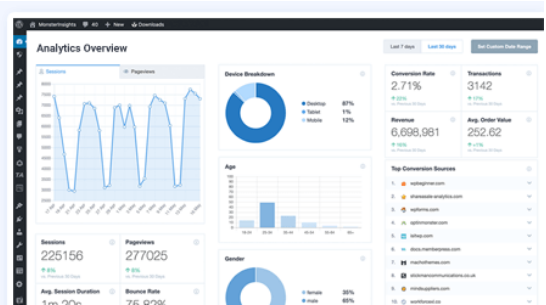Analyzing sales and performance data is crucial for understanding the effectiveness of your marketing strategies, identifying trends, and optimizing your online store to maximize revenue. By analyzing key metrics, you can gain valuable insights into customer behavior, product performance, and overall store performance. In this guide, we will explore how to analyze WooCommerce sales and performance to gain valuable insights and make data-driven decisions to improve your online store’s success.
Key Metrics to Analyze
Before diving into the analysis, let’s explore some key metrics you should monitor and analyze:
- Total Sales: The total revenue generated by your store over a specific period.
- Conversion Rate: The percentage of website visitors who make a purchase.
- Average Order Value (AOV): The average amount spent by customers per order.
- Top-Selling Products: Identify the best-selling products and their contribution to total sales.
- Customer Lifetime Value (CLV): The total value a customer brings to your store over their entire relationship with your brand.
- Shopping Cart Abandonment Rate: The percentage of customers who add items to their cart but do not complete the purchase.
- Website Traffic Sources: Identify the sources driving traffic to your website (e.g., organic search, social media, paid advertising).
- Bounce Rate: The percentage of visitors who leave your website after viewing only one page.
Read: A Guide To Managing WooCommerce Tax Settings
Tools for WooCommerce Sales and Performance Analysis
WooCommerce provides built-in reports that offer valuable insights into your store’s performance. Additionally, various analytics and reporting plugins can further enhance your analysis capabilities. Some popular tools include:
- WooCommerce Reports: Built-in reports in WooCommerce can be found under “WooCommerce” > “Reports.” These reports provide an overview of sales, orders, and customer data.
- Google Analytics: Integrating Google Analytics with your WooCommerce store allows you to track detailed website metrics, visitor behavior, and e-commerce data.
- MonsterInsights: A popular Google Analytics plugin for WordPress that simplifies tracking and provides user-friendly reports.
- Metorik: A comprehensive WooCommerce analytics plugin that offers detailed insights, customer tracking, and real-time reporting.
Analyzing Sales and Performance Data
Now, let’s dive into the steps for analyzing WooCommerce sales and performance:
Step 1: Set Clear Goals
Before analyzing data, establish clear goals for your analysis. Determine what metrics are most important to your store’s success and what insights you want to gain from the data.
Step 2: Use Built-In WooCommerce Reports
Start by exploring the built-in reports in WooCommerce. Analyze the overview of sales, orders, and customer data. Pay attention to trends, peak sales periods, and any significant changes in performance.
Step 3: Analyze Conversion Funnel
Use Google Analytics or other analytics plugins to analyze the conversion funnel. Track the flow of visitors from landing on your website to completing a purchase. Identify any drop-off points and optimize those stages to increase the conversion rate.
Step 4: Explore Product Performance
Analyze the performance of individual products. Identify top-selling products and determine which products contribute the most to your revenue. Use this data to optimize product pages, pricing, and marketing strategies.
Step 5: Monitor Customer Behavior
Track customer behavior and engagement. Analyze customer segments based on repeat purchases, average order value, and customer lifetime value. Tailor marketing campaigns and loyalty programs to each segment’s needs.
Step 6: Evaluate Marketing Efforts
Analyze the effectiveness of your marketing efforts, such as email campaigns, social media promotions, and advertising. Identify which channels drive the most traffic and conversions, and allocate resources accordingly.
Step 7: Review Website Performance
Monitor website performance metrics like bounce rate, page load times, and mobile responsiveness. A fast and user-friendly website is crucial for retaining customers and improving search engine rankings.
Read: WooCommerce Database Optimization Best Practices
Step 8: Identify and Address Abandoned Carts
Analyze the shopping cart abandonment rate and identify common reasons for cart abandonment. Implement strategies like cart recovery emails or limited-time offers to encourage customers to complete their purchases.
Step 9: Track Traffic Sources
Keep track of traffic sources to understand where your website visitors are coming from. Optimize marketing efforts on high-performing channels and explore opportunities for growth in underperforming areas.
Step 10: Continuously Monitor and Adjust
Regularly review and update your analysis. E-commerce is dynamic, and consumer behavior can change over time. Continuously monitor your data and adjust your strategies accordingly.
Read: A Guide To WooCommerce SSL and HTTPS Setup
Conclusion
Analyzing WooCommerce sales and performance data on WordPress provides valuable insights to optimize your online store for success. By tracking key metrics, understanding customer behavior, and evaluating marketing efforts, you can make informed decisions to boost revenue, improve customer satisfaction, and enhance your store’s performance.
Use the tools and techniques outlined in this guide to gain valuable insights into your WooCommerce store and drive continuous improvement. Data-driven analysis is an essential aspect of achieving higher rankings on Google and growing your e-commerce business.

